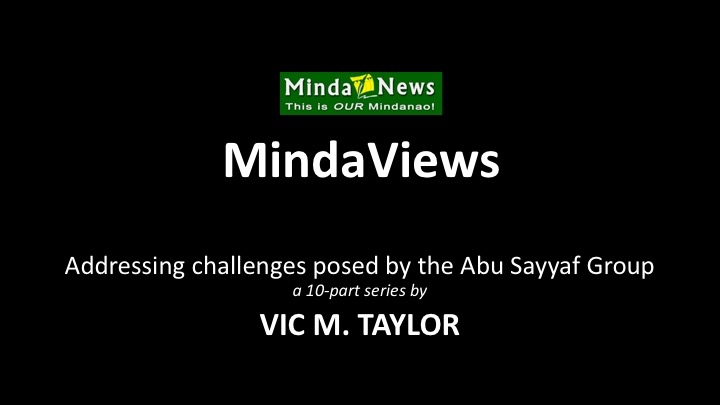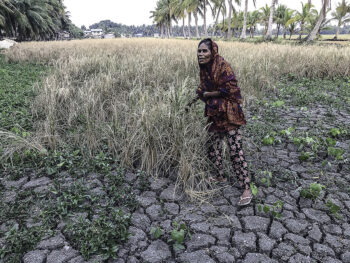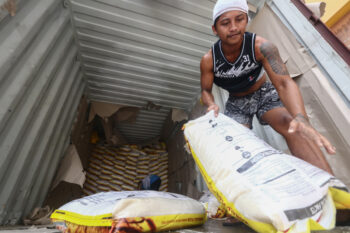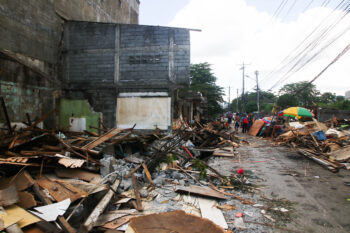3rd of 10 parts
22 May 2017
In the second article in this series we raised the question as to whether feelings of enmity still exist among significant portions of Muslim and Christian Filipinos vis-à-vis each other. Whatever the situation is, whether this is perceived to be a serious issue or not, there is the problem of Muslim Filipinos being influenced by views which engender intolerance vis-à-vis persons of other faiths or even other Muslims who may espouse more openness to non-Muslims.

Without going into the scholarly debates on the definition of the term, and since we are focused on the Abu Sayyaf phenomenon, let us refer to this as the process of radicalization, the process of change in outlook on the part of individuals or groups vis-à-vis others, whether non-Muslims or even Muslims, from one of openness and acceptance to one of intolerance and unwillingness to accept a difference in views.
In the Philippine context, there are at least two trends that are a cause of concern. On the one hand, there is the view on the part of some observers that the Salafi-Wahhabi brand of Islam has spread among the Muslim community and that it is Salafi-Wahhabi doctrines that are being taught in many of the madaris. The other development is the very effective use by the Islamic State (ISIS, ISIL, Daesh) of social media to spread its messages around the globe.
On the first point, the observation has been made that Salafi-Wahhabi doctrines had been introduced to Philippine Muslim communities as long as fifty years ago, when efforts were stepped up to send Filipino Muslim scholars to the Middle East to take up Islamic studies in institutions of religious learning there. This was intensified in the 1970s when the fortunes of the Kingdom of Saudi Arabia skyrocketed with the phenomenal increase in oil prices following the oil embargo at that time. From a gross national income of US$9 billion in 1972 (before the oil embargo of 1973), Saudi Arabia’s gross national income shot up 1.700% to US$165 billion in 1980 and continued to grow since then. This enabled the Kingdom to build mosques and madrasahs around the world, send Saudi religious scholars throughout the world to preach the version of Islam which the Kingdom had adopted, intensify the sponsorship of scholars from various countries to study in Saudi institutions of learning and undertake other activities which spread the Wahhabi doctrines of Islam. It will be recalled that the ancestor of the ruling family of the Kingdom, Muhammad ibn Saud, entered into a partnership with the preacher Muhammad ibn Abd al-Wahhab in the mid-eighteenth century, whereby Abd al-Wahhab provided the religious foundation, the ideology, as it were, upon which the political rule of the Saud family would be based.
While this writer has no pretensions of being a scholar on Islam, the danger posed by Wahhabi-Salafi doctrines is that they result in an attitude of intolerance not just towards non-Muslims but even towards other Muslims who may hold other views. This intolerance could eventually – but not necessarily – lead to the use of violence to impose one’s belief on others.
So the base of a radical Islamic outlook would appear to have long been in place in the Philippines already. It is upon this base that the Islamic State appears to be spreading its influence, working through the adherents who have pledged allegiance to it.
In its mission to gain more support for its cause, the Islamic State has deftly and effectively utilized advances in communication technology to deliver certain key messages. These messages have been summarized by Thomas Koruth Samuel, a Director at the Southeast Asia Centre for Counter-Terrorism, as follows:
- The establishment of a Caliphate as prophesied by the Prophet Mohammed. Islam is supposed to have developed over time as follows:
- The era of the Prophet, which represented the purest form of the practice of Islam;
- The period of the Caliphs who followed the Prophet;
- The period from the Umayyad Dynasty to the Ottoman Empire;
- The period of the various post-colonial Muslim states of the 20th century;
- The resurrection of the Caliphate, harking back to the period of the Prophet.
- The battle to end all battles will take place in Sham (present-day Syria) and will be undertaken by the Army of Mahdi carrying black banners to liberate Jerusalem and resurrect the Caliphate.
- All Muslims should join this final battle, a once-in-a-lifetime opportunity, to establish and spread the domain of the final Caliphate.
- All Muslims should join this final battle to help their brothers who are being oppressed by the Shia-dominated regimes in Syria and Iraq.
- Joining this final battle will atone for past misdeeds and un-Islamic actions. (Thomas Koruth Samuel, “Radicalisation in Southeast Asia: A Selected Case Study of Daesh in Indonesia, Malaysia and the Philippines”).
To these messages we may add the more recent message (June 2016) addressed to Muslims in this region to go to the Philippines and join the struggle here instead of going to Syria or Iraq.
Whether these messages resonate with Filipino Muslims remains to be seen but, as is well known, a number of groups have openly pledged their support to IS and its self-proclaimed Caliph, Abu Bakr al-Baghdadi. These groups include the ASG in Basilan (under its formal name Al-Harakatul Al-Islamiyah), Katibat Ansar al-Shariah (headed by a Malaysian going by the name Abu Anas al-Muhajir who was killed shortly after having pledged loyalty to IS), Ma’rakah al-Ansar (supposedly from Sulu), Ansarul Khilafah Philippines (operating in the Sarangani, Sultan Kudarat, South Cotabato area and whose leader, Mohammad Jaafar Maguid, was killed in January of this year), the BIFF, the Maute Group (IS Ranao).
Often, discussions on radicalization focus on radicalization of the youth. Certainly that is an important focus given the fact that it is young people who are recruited into the ranks of extremist groups. It is the younger generation that ISIS has been targeting with its army of social media practitioners. Maria Ressa, for example, pointed out that in a study done in early 2015, a minimum of 46,000 Twitter accounts were being used by IS. Moreover, around 200,000 pieces of social media were being created every day (Maria Ressa, “How to fight ISIS on social media”, Rappler, August 26, 2015).
Furthermore, as anyone who has seen any of the videos produced and disseminated by IS will attest, these are not crude slapdash affairs but well-crafted and skillfully produced works. Ressa has embedded in her article a video of a Canadian jihadi who described his background in Canada – being like any ordinary young Canadian male, playing hockey, going to the cottage in the summertime, fishing, hunting, while all the time snippets of these outdoor events are shown as he speaks. He describes himself as a good person, someone who had a regular job, friends, family, and not an anarchist as others might think. He briefly describes why he joined IS. Then the video shows him in battle, apparently with the use of a drone following his movements as he runs across a field with his gun, until an explosion turns him into a martyr for the faith.
Blaker describes the social media appeal of ISIS in this way:
“The ISIS propaganda wing, al-Hayat, continues to produce slick videos that mimic Hollywood action films and music videos and are obviously targeted to young Westerners. The videos often include music with lyrics translated to English and a number of European languages. More recent videos feature English-speaking jihadists. Notes Sam Heuston, a professor of English and film studies at The Citadel who has written about extremist video propaganda, ‘It’s actually surprising how contemporary and hip-looking some of these things are, especially considering the fact that the messages that they are promoting are essentially medieval.’” (Lisa Blaker, “The Islamic State’s Use of Online Social Media”, Military Cyber Affairs, Vol. I, Issue I, Article 4, 2015).
Given the observation that salafi views have been influencing Filipino Muslims for several decades now – more than half a century, it would appear – it would be essential to determine to what extent whole communities have been influenced. To what extent is intolerance in matters of faith being handed down from generation to generation? Because if the younger generations are being brought up with closed minds and with a sense of suspicion or even hatred toward those who are different from themselves, then attention should be given to the family and the communities within which these outlooks are being nurtured, and not just the madaris which are often the focus of “de-radicalization” campaigns.
A Tausug friend the author asked about this phenomenon commented that it is in the gimba, the interior, where this kind of outlook would be found, particularly among those who have not had an opportunity to get a proper education. But one wonders. Those who have gone abroad for higher studies are exposed to extremist views. One does not even have to go abroad. It has been observed that many of the madaris in fact adopt a salafi perspective in their teachings. And in this age of the global reach of communication technologies anyone who has a smartphone can download extremist writings, videos and audio messages. The author knows highly educated individuals who take a perverted pleasure in watching videos of Abu Sayyaf beheadings and encouraging others to watch them as well.
Researchers on terrorism point out that only a small proportion of those who are radicalized actually take the plunge and resort to violence. And among those who do, the motivating factors are varied. There are, certainly, those who are impelled by ideological convictions. But there are also those who take up arms (or set off bombs) for other reasons.
Samuel points to an interesting study undertaken by U.S. Army Colonel John Venhaus which looked at why young people joined al-Qaeda, based on interviews and personal histories of over 2,000 foreign fighters. Venhaus identified four categories of motivations:
- “Revenge seekers”, wanting to exact retribution for some perceived wrong or injustice suffered in the past, whether experienced personally (such as the Anak Ilu or orphans in Sulu) or perceived collective grievances suffered by the Muslim community as a whole.
- “Status seekers”, looking for some form of recognition.
- “Identity seekers”, needing to join a group which would give them a sense of identity.
- “Thrill seekers”, looking for adventure. (Thomas Koruth Samuel, study on radicalization in Southeast Asia cited earlier.)
The latter category, thrill seekers, recalls the description of Tausug males by anthropologist Thomas Kiefer:
“Risk taking in Tausug culture is encouraged, and the prudent lose the opportunity to demonstrate to their fellows valued virtues of character: bravado, honor, masculinity, and even magnanimity. Outlaws, criminals, well-known thieves and the ever-present seekers after revenge are admired as persons of strong character who have demonstrated their willingness to seek dangerous situations, or to accept them voluntarily when luck has made them inevitable. Long epic songs glorify heroes who have excelled in these virtues.” (Thomas M. Kiefer, “The Tausug: Violence and Law in a Philippine Moslem Society”.)
But even if ideology is not the primary motivation, there is more often than not, an ideological underpinning which justifies individual or group actions. For example, one kidnap victim the writer is acquainted with recounted how the ASG commander justified the kidnapping as payback for the decades of exploitation by Christians of Muslims lands and the resources on them. They were just getting back what had been stolen from them.
There is, of course, another category, whom one could refer to as Opportunists, who essentially are riding on the image or reputation of the ASG but for purely financial objectives. These are basically the criminal types who would need to be dealt with differently.
The roots or sources of the radicalization need to be analyzed and understood. The approaches and the messaging for the various categories will need to be appropriately formulated. The religious underpinnings of the militant groups need to be countered through what Kruglanski et al. refer to as a “religious dialogue component”. In a study undertaken they describe how this is done in Yemen, Saudi Arabia, Indonesia and Singapore. In Singapore, for example, a community-based Religious Rehabilitation Group (RRG) was set up which “carried out an extensive analysis of the JI (Jemaah Islamiyah) interpretation of Islam and offered credible scholarly answers to the extremists’ arguments”. (Arie W. Kruglanski, Michele J. Gelfand, Rohan Gunaratna, “Aspects of Deradicalization”, Institute for the Study of Asymmetric Conflict.)
The grievances need to be addressed. Often these refer to persons killed, whether they were ASG fighters or not, with family members wishing to exact revenge. There is also the matter of disappearances, persons picked up on suspicion of being connected with the ASG, never to be heard from again. The writer is aware of a number of such cases brought to his attention in recent months.
Because more often than not interpretations of religious issues are involved, the guidance of the region’s religious leaders is essential. It is they who can speak with authority on matters of faith and respond to the dogmas presented by extremists as the basis for their terroristic activities. For this reason, the region’s religious leaders need to take a leading role in the fight against the Abu Sayyaf, a topic we shall touch on in a subsequent article.
TOMORROW: Governance
[Vic M. Taylor, originally from Cebu, has been involved in various peace and development activities in Mindanao, particularly in Basilan-Sulu-Tawi-Tawi (BaSulTa) in the different positions he has held in government and the private sector over the last 50 years.
He started as an instructor at the Notre Dame of Jolo College after his graduation from the Ateneo de Manila University in the late 1960s. Subsequently, he oversaw the Rehabilitation and Development Program for Muslim Mindanao during the early years of martial law under the Office of the President.
Within the last 16 years and upon the request of the families of some kidnap victims, Mr. Taylor assisted these families to help secure the safe release of five victims from the ASG.
Recently, he has been working with a private group that is assisting a community of the Moro National Liberation Front in the Zamboanga peninsula in bringing development projects to their area.
This series is a revised version of a paper written by the author for the Mackenzie Institute, a Canadian security think tank, in light of the execution of two Canadian hostages by the Abu Sayyaf last year]






